When the time comes to undertake a lighting project, it is vital that a rigorous study and design process is followed, with the aim of illuminating a space in a way that is coherent with its architecture, décor and expected uses.
An essential part of this process involves analysing and determining the following aspects, among others:
- Architecture and footprint
- Activity and uses of the installation
- Optimal distribution of light points
- Appropriate lighting levels
- Light tonality
- Energy consumption
- Maintenance
- Proposed lighting fixtures and control/management systems
- Economic budget
For this, it is very important to keep in mind the components that comprise any LED lighting system:
- Dimmer or control system
- Driver
- LED module/s
- Luminaire
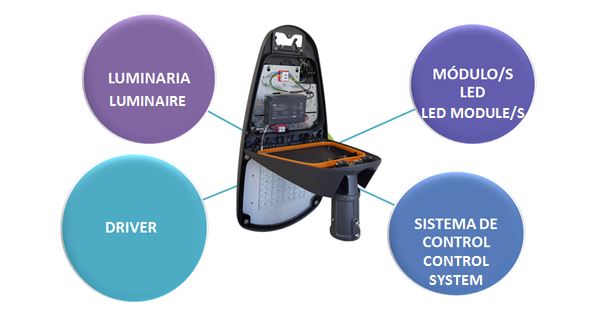
Within this system, we can think of the driver as its “brain” as, in addition to being responsible for controlling its most basic function (lighting), it also plays a fundamental role in a wide range of aspects including: protection, functionality, dimming methods, programming options, uses, flexibility, electrical behaviour, performance and aesthetics.
Apart from these widely-known parameters in the sector, there is another series of points to take into account which, unfortunately, are not usually given the attention they require. These aspects play a key role in lighting projects due to the fact that they are directly related to lighting quality, user experience, comfort levels…
As a result, making the right choice and testing the driver that comprises the lighting system is very important. This article discusses the importance of this component in relation to some of the above-mentioned and, generally, lesser known aspects within the world of lighting.
FLICKER
One significant problem that affects LED lighting is the flicker, which we define as variations of luminance (the amount of light flow that affects a surface) in time.
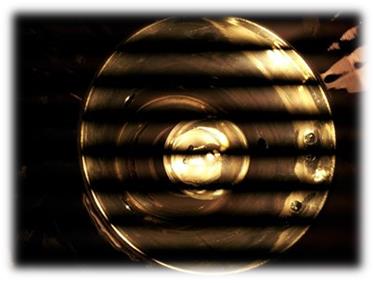
There are primarily two types of flicker: visible and invisible:
- visible flicker is that which human beings can observe and which is generally deemed as objectional, except in some specific applications such as stroboscopic lights.
- Invisible flicker is that which is not consciously perceived by human beings, but in spite of which, can have adverse effects on their health such as, for example, neurological problems, headaches, visual fatigue…
Traditionally, flicker used to be a problem in the case of fluorescent lamps in combination with magnetic ballasts, however the issue was largely corrected following the arrival of electronic ballasts. It is also worth pointing out the slow nature of fluorescent and incandescent lamps,which means that when these lamps are turned off, they remain on for a short period of time, thereby making the flicker less appreciable. This radically changed with LED lighting, as this represents a rapid form of light source, making the variations in current experienced appear almost instantly in the light delivered.
There are two points that must be very much taken into account when assessing the flicker present in our lighting system: flicker percentage and flicker frequency.
The flicker percentage alludes to the amount of flicker present in a determined frequency. It is calculated by means of the following formula:
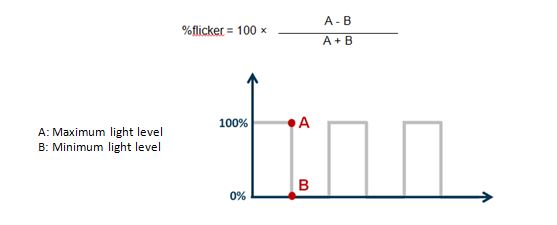
A smaller flicker percentage level always means less flicker, but this fact alone does not guarantee high quality lighting.
In order to ensure lighting quality, the flicker frequency must also be taken into account. This concept refers to the rate at which the light output varies in time and is important because a specific amount of flicker produced at 100 Hz (graph on the left) does not have the same effects as an amount that which is produced at 1 kHz (graph on the right).

To determine, represent and compare these parameters, methods exist such as that included in the IEE P1789 standard. As the following image shows, flicker is more damaging the lower the frequency at which it is produced.
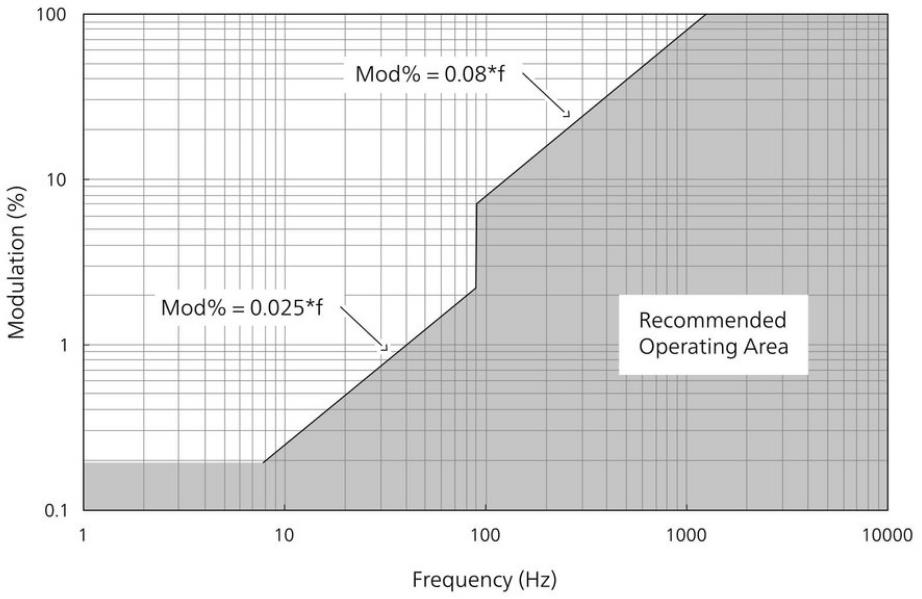
As we have mentioned, it is very important to take this parameter into account in any lighting project due to its adverse effects on the health of people. This is extremely important in spaces in which human beings are exposed to artificial light over prolonged periods, such as in hospitals, schools and offices.
In this regard, the driver plays a leading role as it is responsible for controlling and regulating the current that circulates through the LED modules, being the main factor that gives rise to the presence of flicker as well as its percentage and frequency characteristics in a lighting system.
Within the field of the electronic development of drivers, the following output current dimming methods can be highlighted:
- Pulse Width Modulation (PWM) → fast power-on/off of the LED module at a high frequency.

- Amplitude modulation → reduction in the level of current circulating through the LED modules.
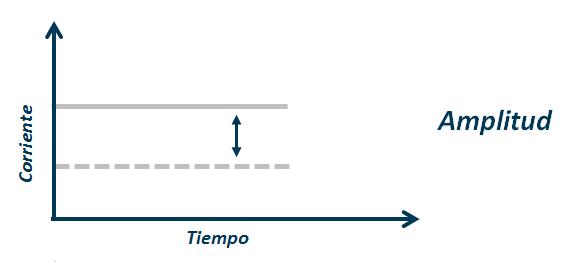
- Hybrid methods → a combination of both of the above.
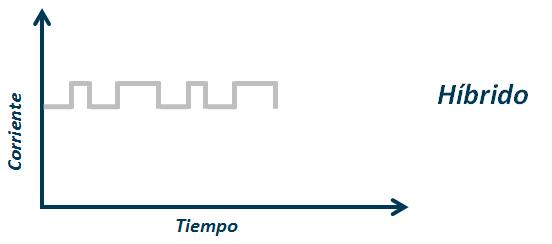
Each dimming method has its benefits and drawbacks, so it is important to have a first-hand understanding of them when making the best selection of driver based on the parameters of our lighting project:
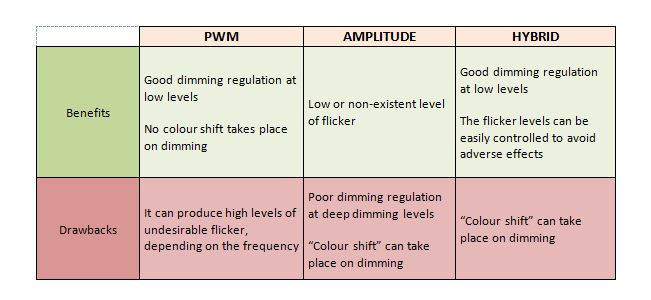
The term “colour shift” refers to variations in the colour temperature that occur when the level of the current circulating through an LED module is modified.
TRANSITIONS
Another aspect worth highlighting are the transitions. Transitions refer to the change between the different statuses of a driver. There are generally aspects that are not stated in the documentation associated with lighting products and largely depend on the management functions carried out by the driver (although, as we will see later, this is not the only factor).
The following main transitions can be highlighted:
- Power-on/off of the driver (mains)
- Input/output rest mode (standby)
- Transitions between dimming statuses
- Input/output to protection modes (overload, open circuit…)
When the driver is powering on and off (mains), power surges can appear above their nominal value that give rise to deterioration in the LED load used.
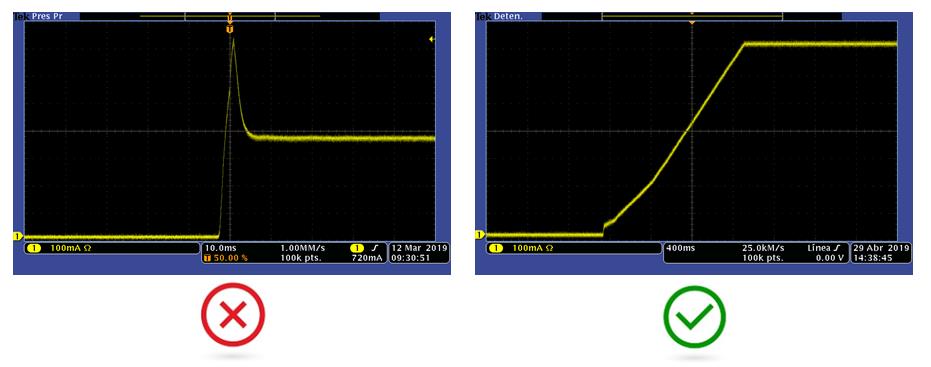
Due to the initialisation of the electronics comprising the output control of the driver, flickering or pulses of current can be produced that, depending on their duration or intensity, are even visible to the naked eye.
These transitions between dimming statuses can be observed as "in steps" or as abrupt and irregular variations in the output current that directly impact on the user’s perception of quality regarding the lighting system used.
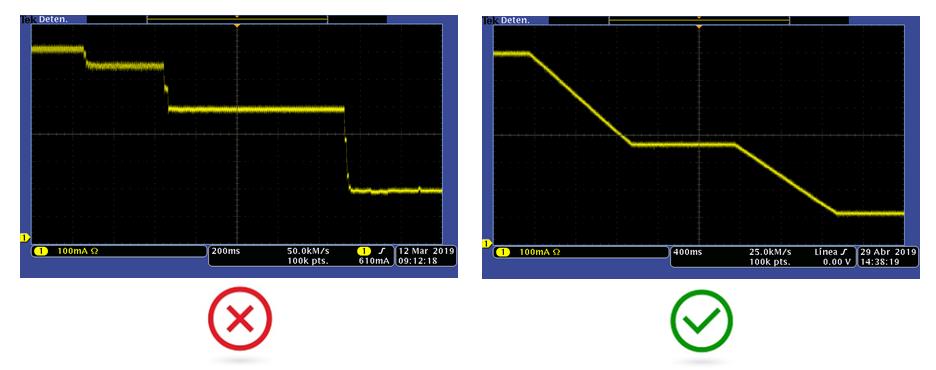
The general premise to follow must be that of managing these transitions to achieve a compromise between the fastest and the most “pleasant” ways possible without causing undesirable behaviour that affects the experience of the user, the level of comfort or the quality of our lighting system. As such, these impacts must be taken into account prior to the design of the driver to try to eliminate or mitigate them during the initial phases of product development.
COMPATIBILITY
We also need to stress the importance of compatibility between the different parts of a lighting system.
On one hand, it is necessary to guarantee the correct relationship between the LED modules and the driver used, with all that this involves. But beyond this aspect, which is widely known within the sector, it is also necessary to ensure compatibility between the driver and the control devices.

In installations controlled via phase-cut, it is necessary to check that the dimming method (start or end of the phase) is compatible with every device. Moreover, it is necessary to ensure that the type of load to be controlled and its output are always within the range permitted by the control gear. Lastly, it is a good idea to check that no audible noise or flickering takes place in any of the permitted dimming conditions.

In installations controlled via the DALI protocol, the most important thing is to ensure that every installed device is DALI certified. In this way, we can guarantee compliance with strict testing protocols that involve the compatibility of communications between them. In addition, due to the digital nature of the protocol, it is particularly important that the manufacturer's recommendations are followed and that every device is correctly configured. In this type of installation, its commissioning phase is very important as well as being complex, meaning that it must be correctly undertaken by a professional.

In installations controlled via 1-10V, we must bear in mind that this is an analogue and less standardised protocol compared to DALI. As such, it is necessary to follow the manufacturers’ recommendations of the different devices, particularly taking into account the dimming curves and the maximum number of devices to be controlled, as well as the electrical parameters of the control inputs/outputs with the aim of achieving a linear sensation and a correct dimming range.
In addition to taking into account these particular considerations of the main dimming and control methods, the entire lighting system must be tested in order to select the most appropriate components and achieve the optimal configuration to guarantee compatibility between every part.
Given all the points highlighted above and due to the importance of the role played by the drive in achieving quality lighting, it is very important to make the right choice of device as well as undertake the appropriate testing of this component along with all the other parts that comprise the lighting system, with particular attention to some aspects that could have a negative impact on the functionality and comfort level of our installation.
Overall, the choice of a driver with reduced levels of flicker, proper transitions management and full compatibility with the rest of the system components, allows us to add value to lighting projects, increasing the sensation of quality perceived by the end user.
Adrián Garcés Clemente
ELT R&D Engineer

